The Mountain of God
Jebel Madhbah, overlooking the ruins of Petra in southern Jordan. Was this the real Mountain of God?
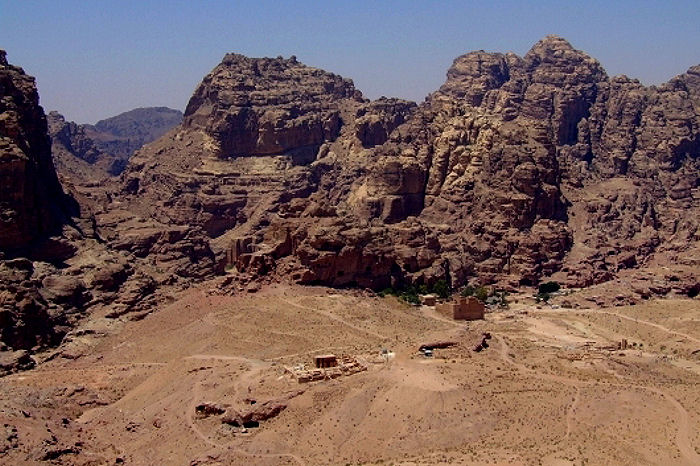
The heart of the ancient kingdom of Edom was situated in a valley once called the Valley of Edom, now known as the Wadi Musa. Wadi Musa means Valley of Moses, so named by the local Bedouin because they have long believed that this was where Moses created his miraculous spring. In fact, there is a shrine at the entrance to the Siq, the narrow gorge that enters the valley, called Ain Musa - the Spring of Moses. It houses a freshwater spring said to mark that very spot. If this was the place the Exodus author had in mind when he wrote of Moses creating the miraculous spring at Horeb, the mountain of God, then the mountain that rises above it, now called Jebel Madhbah, may have been the real Mount Sinai.
Jebel Madhbah
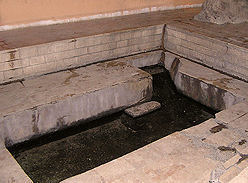
Ain Musa, said to be the miraculous spring created by Moses himself.
The Treasury in the Outer Siq.
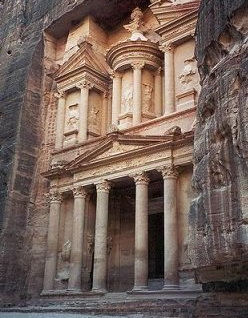
The Trumpet Exceedingly Loud
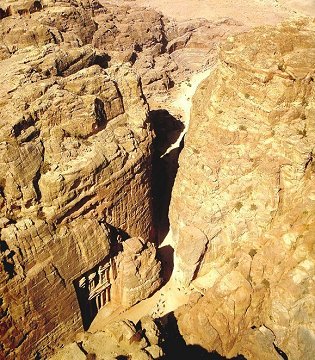
According to the Old Testament, when Moses first brought the Israelites to Mount Sinai, they made camp at the foot of the mountain and prepared to meet with God Himself. They had not been there long when the presence of God descended on the mountain above them. If the Outer Siq is where the Israelites camped, then there is an unusual natural phenomenon that occurs here that might explain one passage in the Bible. According to Exodus 19:16:
There were thunders and lightnings, and a thick cloud upon the mount, and the voice of the trumpet exceeding loud; so that all the people that was in the camp trembled.
It seems that a violent storm was raging around the mountain. When a strong easterly wind blows through the Siq, it howls through the rocks to create the strangest sound. The noise it makes is not only eerie; if you happen to be in the gorge itself it is deafening. The sound can only be described as a bizarre cacophony of Buddhist prayer horns being blown in unison. Could this have been the “voice of the trumpet exceeding loud” that had frightened the ancient Israelites?
View down into the Outer Siq with the sheer cliffs of Jebel Madhbah rising above the Treasury. A strange sound made by the wind howling through the Siq may have been "the trumpet exceedingly loud" the Israelites are said to have heard when camped at the foot of Mount Sinai. (Photograph: Jane Taylor.)
For a virtual view of the Outer Siq, where the Israelites may have camped, click> HERE.
Obelisk Terrace
Jebel Madhbah means the 'Mountain of the High Place', so called because of the remains of an ancient religious sanctuary known as the High Place that still survives on the summit. The sanctuary consists of an open-air temple at the summit, and below it, a rocky terrace where there stand two huge obelisks. This stony plateau, known both as Attuf Ridge and Obelisk Terrace, is joined to the summit by an ascending ridge, around 500 feet long, and seems to have formed the ceremonial entrance to the mountain-top temple.

Obelisk Terrace on Jebel Madhbah. Was this the "nether part of the mountain" where the Israelites were taken by Moses to meet with God?
Obelisk Terrace is about two hundred feet long by a hundred feet wide, and the two huge monuments after which it is named rise from either side of it. These towering obelisks, each over twenty feet high, are sculpted from the mountain bedrock. To create these freestanding columns of stone, the makers had to hack away solid rock from all around them – over 400,000 cubic feet of it – an astonishing achievement for a people without modern technology. Until recently, this was believed to have been a Nabatean creation, because one of the obelisks was inscribed with Nabatean symbols at some point in time. Now, however, it is thought to have been the work of the earlier Edomites. Excavations of the quarried stone found around the plateau have uncovered organic remains (such as animal bones) that have been radiocarbon dated to around 1500 BC. Remarkably, therefore, these monuments may well have been here when the Israelites appear to have left Egypt to wander in the Sinai Wilderness. Interestingly, as the Edomites shared a common Hebrew ancestry with the Israelites, the mountain-top sanctuary might even have been a site where the Hebrew God was being venerated by the Edomites at the time of the Exodus.

One of the obelisks on Obelisk Terrace which the Bedouin call "the feet of God". Were these twenty-foot high, solid stone pillars the feet of God described in the Exodus account of Mount Sinai?
The Lord will come down in the sight of all the people upon Mount Sinai . . . And Moses brought forth the people out of the camp to meet with God; and they stood at the nether part of the mount. (Exodus 19:11-17)
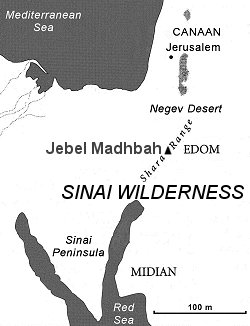
The implication here is that there were two levels to the sacred site where God was to be encountered. As “nether” means “lower,” the people must have stood on some lower precinct to the sacred mountain top where Moses later received the Ten Commandments - precisely as would have been the case if the Israelites had ascended Jebel Madhbah to arrive at Obelisk Terrace.
And they saw the God of Israel: and there was under his feet as it were a paved work of a sapphire stone. (Exodus 24:10)
Sapphires are blue, and the concourse was paved with polished blue slate, which might well have shone like sapphire in the sunlight. The Bedouin tradition refers to the obelisks as the feet of God, and the biblical account specifically refers to God’s feet. This does in fact answer a puzzling question. Why had the ancient Israelites regarded God as having feet? Like the Bedouin, the Exodus scribe may have been confused by the Edomite word for pillar.
The location of Jebel Madhbah in the Shara Mountains.
On its eastern side Jebel Madhbah is surrounded
by steep cliffs, and to reach the only way up the mountain you have to pass through the Siq. This deep, narrow cleft winds some half a mile through sheer
rock until it opens into a wider gorge, known as the Outer Siq, running
down into the valley which had once been the heart of the Edomite kingdom.
Where the Siq enters this gorge there is an impressive monument cut into
the opposite cliffs, known as the Treasury. This
130-foot edifice, carved with two tiers of towering columns, colossal
pediments, statue niches, and ornamental
urns, all cut into the sheer rock face, is the entrance to a number of
vast chambers cut deep inside the mountain. It is the remains
of a 2,000-year-old tomb built by the Nabateans from Arabia who
occupied the area during Roman times. The ruins of hundreds of their
buildings and monuments now dominate the Wadi Musa: the remains of their
ancient city of Petra. However, Petra and its surrounding monuments
were not built until over a thousand years after the time of Moses and the
Exodus. During the time of the ancient Israelites the area was home
to the Edomites whose earlier buildings have been excavated here. It is at the spot
where the Treasury now stands that the Israelites may have camped when
they arrived at the Mountain of God.
Up on the mountain of Jebel Madhbah, rising above the Treasury, there is more compelling evidence that this was indeed the Mountain of God.
Obelisk Terrace would have been even more impressive in ancient times. Archaeologists have found broken slabs of worked slate in the scree around the plateau, and have concluded that it was originally used to form a paved area around the obelisks. After examining the slate fragments in detail, the archaeologists reckoned that they had been polished to create a shiny blue surface for the concourse where, it would seem, religious ceremonies took place. In fact, the Bedouin still consider this plateau to be sacred ground; they even call these monuments “the feet of God,” as they have a tradition that God once stood here. It has been suggested that legend originated because the Edomite word for foot was the same as their word for pillar.
The topography of the mountain does indeed match the descriptions of Mount Sinai in the Old Testament. The split level of the Jebel Madhbah sanctuary - Obelisk Terrace below the temple at the summit - certainly fits with what we are told of the Israelite’s first encounter with God on Mount Sinai. After he had produced the miraculous spring, and the Israelites made camp at the foot of the mountain, Moses prepared his people to meet with God:
Remarkably, in a further passage concerning the Israelites on the nether part of the mountain, the Bible seems to give an exact description of how Obelisk Terrace would originally have looked:
Page 3 of 4








